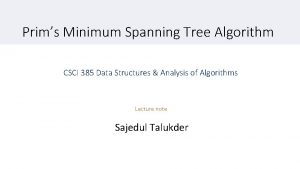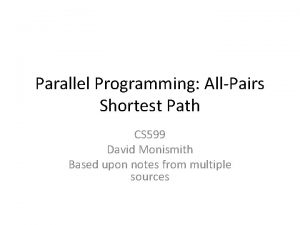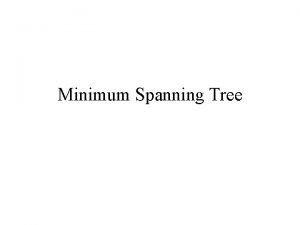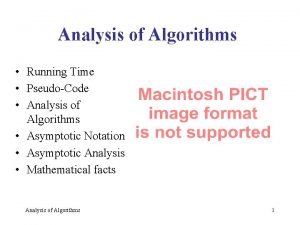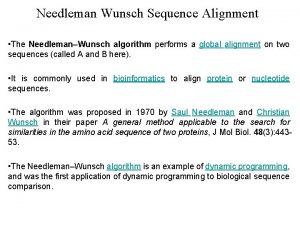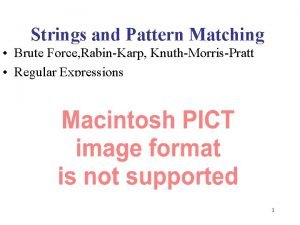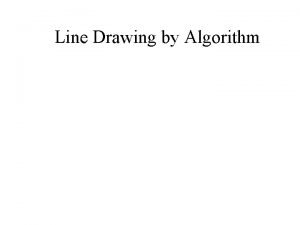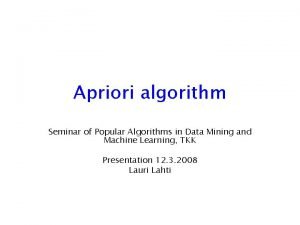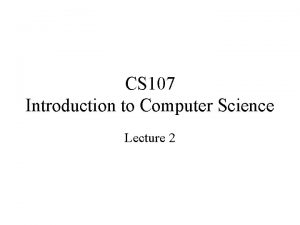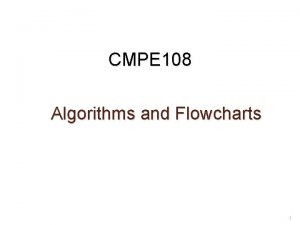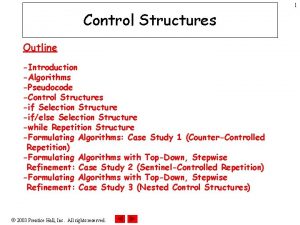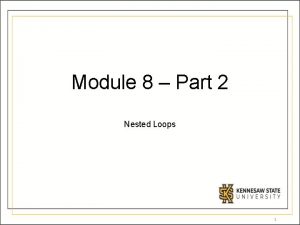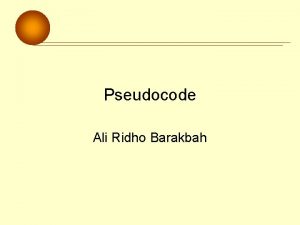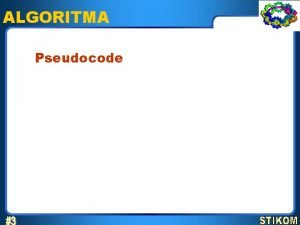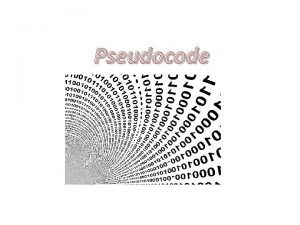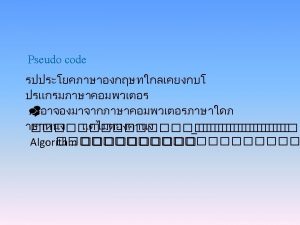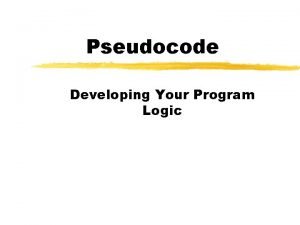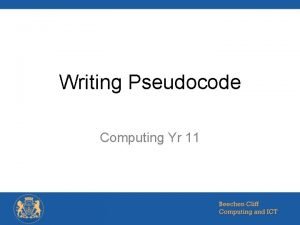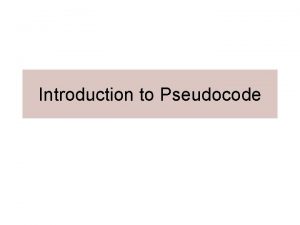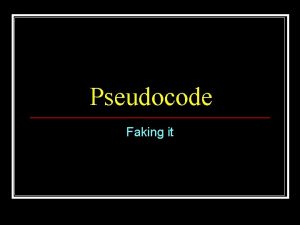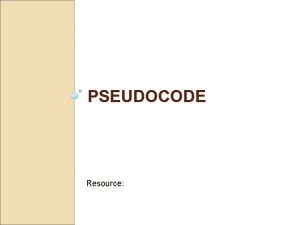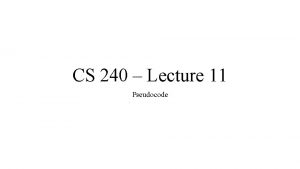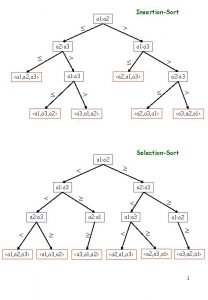Pseudocode Example insertionsort algorithm Section 3 1 2
![Pseudocode Example: insertion-sort algorithm [ Section 3. 1. 2 ] Pseudocode Example: insertion-sort algorithm [ Section 3. 1. 2 ]](https://slidetodoc.com/presentation_image_h/026b7d953559d70574d4c6b1ab031722/image-1.jpg)
![Pseudocode Example: insertion-sort algorithm High-level pseudocode: [ Section 3. 1. 2 ] Pseudocode Example: insertion-sort algorithm High-level pseudocode: [ Section 3. 1. 2 ]](https://slidetodoc.com/presentation_image_h/026b7d953559d70574d4c6b1ab031722/image-2.jpg)
![Pseudocode Example: insertion-sort algorithm More detailed pseudocode: [ Section 3. 1. 2 ] Pseudocode Example: insertion-sort algorithm More detailed pseudocode: [ Section 3. 1. 2 ]](https://slidetodoc.com/presentation_image_h/026b7d953559d70574d4c6b1ab031722/image-3.jpg)
![Pseudocode Example: insertion-sort algorithm Java-code: [ Section 3. 1. 2 ] Pseudocode Example: insertion-sort algorithm Java-code: [ Section 3. 1. 2 ]](https://slidetodoc.com/presentation_image_h/026b7d953559d70574d4c6b1ab031722/image-4.jpg)

![Singly linked lists What are they? [ Section 3. 2 ] Singly linked lists What are they? [ Section 3. 2 ]](https://slidetodoc.com/presentation_image_h/026b7d953559d70574d4c6b1ab031722/image-6.jpg)





![Doubly linked lists Picture: What classes do we need? [ Section 3. 3 ] Doubly linked lists Picture: What classes do we need? [ Section 3. 3 ]](https://slidetodoc.com/presentation_image_h/026b7d953559d70574d4c6b1ab031722/image-12.jpg)


![Doubly linked lists Insert an element in the middle [ Section 3. 3 ] Doubly linked lists Insert an element in the middle [ Section 3. 3 ]](https://slidetodoc.com/presentation_image_h/026b7d953559d70574d4c6b1ab031722/image-15.jpg)
![Doubly linked lists Delete an element in the middle [ Section 3. 3 ] Doubly linked lists Delete an element in the middle [ Section 3. 3 ]](https://slidetodoc.com/presentation_image_h/026b7d953559d70574d4c6b1ab031722/image-16.jpg)
![Stacks Last-in-first-out (LIFO) Which methods might be useful? [ Section 5. 1 ] Stacks Last-in-first-out (LIFO) Which methods might be useful? [ Section 5. 1 ]](https://slidetodoc.com/presentation_image_h/026b7d953559d70574d4c6b1ab031722/image-17.jpg)
![Stacks How to implement? [ Section 5. 1 ] Stacks How to implement? [ Section 5. 1 ]](https://slidetodoc.com/presentation_image_h/026b7d953559d70574d4c6b1ab031722/image-18.jpg)
![Stacks [ Section 5. 1 ] The first application: matching parentheses (or tags in Stacks [ Section 5. 1 ] The first application: matching parentheses (or tags in](https://slidetodoc.com/presentation_image_h/026b7d953559d70574d4c6b1ab031722/image-19.jpg)
![Stacks [ Section 5. 1 ] The first application: matching parentheses (or tags in Stacks [ Section 5. 1 ] The first application: matching parentheses (or tags in](https://slidetodoc.com/presentation_image_h/026b7d953559d70574d4c6b1ab031722/image-20.jpg)
![Queues First-in-first-out (FIFO) Which methods might be useful? [ Section 5. 2 ] Queues First-in-first-out (FIFO) Which methods might be useful? [ Section 5. 2 ]](https://slidetodoc.com/presentation_image_h/026b7d953559d70574d4c6b1ab031722/image-21.jpg)
![Queues How to implement? [ Section 5. 2 ] Queues How to implement? [ Section 5. 2 ]](https://slidetodoc.com/presentation_image_h/026b7d953559d70574d4c6b1ab031722/image-22.jpg)
![Queues Pseudocode for implementation via circular arrays [ Section 5. 2 ] Queues Pseudocode for implementation via circular arrays [ Section 5. 2 ]](https://slidetodoc.com/presentation_image_h/026b7d953559d70574d4c6b1ab031722/image-23.jpg)
![Lists, Stacks, Queues [ Sections 3. 2 -3, 5. 1 -2 ] A little Lists, Stacks, Queues [ Sections 3. 2 -3, 5. 1 -2 ] A little](https://slidetodoc.com/presentation_image_h/026b7d953559d70574d4c6b1ab031722/image-24.jpg)
- Slides: 24
![Pseudocode Example insertionsort algorithm Section 3 1 2 Pseudocode Example: insertion-sort algorithm [ Section 3. 1. 2 ]](https://slidetodoc.com/presentation_image_h/026b7d953559d70574d4c6b1ab031722/image-1.jpg)
Pseudocode Example: insertion-sort algorithm [ Section 3. 1. 2 ]
![Pseudocode Example insertionsort algorithm Highlevel pseudocode Section 3 1 2 Pseudocode Example: insertion-sort algorithm High-level pseudocode: [ Section 3. 1. 2 ]](https://slidetodoc.com/presentation_image_h/026b7d953559d70574d4c6b1ab031722/image-2.jpg)
Pseudocode Example: insertion-sort algorithm High-level pseudocode: [ Section 3. 1. 2 ]
![Pseudocode Example insertionsort algorithm More detailed pseudocode Section 3 1 2 Pseudocode Example: insertion-sort algorithm More detailed pseudocode: [ Section 3. 1. 2 ]](https://slidetodoc.com/presentation_image_h/026b7d953559d70574d4c6b1ab031722/image-3.jpg)
Pseudocode Example: insertion-sort algorithm More detailed pseudocode: [ Section 3. 1. 2 ]
![Pseudocode Example insertionsort algorithm Javacode Section 3 1 2 Pseudocode Example: insertion-sort algorithm Java-code: [ Section 3. 1. 2 ]](https://slidetodoc.com/presentation_image_h/026b7d953559d70574d4c6b1ab031722/image-4.jpg)
Pseudocode Example: insertion-sort algorithm Java-code: [ Section 3. 1. 2 ]

Pseudocode - What is a pseudocode? - Why do we use it? [ Section 3. 1. 2 ]
![Singly linked lists What are they Section 3 2 Singly linked lists What are they? [ Section 3. 2 ]](https://slidetodoc.com/presentation_image_h/026b7d953559d70574d4c6b1ab031722/image-6.jpg)
Singly linked lists What are they? [ Section 3. 2 ]

Singly linked lists Which classes and methods do we need? [ Section 3. 2 ]

Singly linked lists Inserting an element - at the beginning [ Section 3. 2 ]

Singly linked lists Inserting an element - at the end [ Section 3. 2 ]

Singly linked lists Deleting an element - at the beginning [ Section 3. 2 ]

Singly linked lists Deleting an element - at the end ? [ Section 3. 2 ]
![Doubly linked lists Picture What classes do we need Section 3 3 Doubly linked lists Picture: What classes do we need? [ Section 3. 3 ]](https://slidetodoc.com/presentation_image_h/026b7d953559d70574d4c6b1ab031722/image-12.jpg)
Doubly linked lists Picture: What classes do we need? [ Section 3. 3 ]

Doubly linked lists Insert an element - at the head - at the tail [ Section 3. 3 ]

Doubly linked lists Delete an element - the head - the tail [ Section 3. 3 ]
![Doubly linked lists Insert an element in the middle Section 3 3 Doubly linked lists Insert an element in the middle [ Section 3. 3 ]](https://slidetodoc.com/presentation_image_h/026b7d953559d70574d4c6b1ab031722/image-15.jpg)
Doubly linked lists Insert an element in the middle [ Section 3. 3 ]
![Doubly linked lists Delete an element in the middle Section 3 3 Doubly linked lists Delete an element in the middle [ Section 3. 3 ]](https://slidetodoc.com/presentation_image_h/026b7d953559d70574d4c6b1ab031722/image-16.jpg)
Doubly linked lists Delete an element in the middle [ Section 3. 3 ]
![Stacks Lastinfirstout LIFO Which methods might be useful Section 5 1 Stacks Last-in-first-out (LIFO) Which methods might be useful? [ Section 5. 1 ]](https://slidetodoc.com/presentation_image_h/026b7d953559d70574d4c6b1ab031722/image-17.jpg)
Stacks Last-in-first-out (LIFO) Which methods might be useful? [ Section 5. 1 ]
![Stacks How to implement Section 5 1 Stacks How to implement? [ Section 5. 1 ]](https://slidetodoc.com/presentation_image_h/026b7d953559d70574d4c6b1ab031722/image-18.jpg)
Stacks How to implement? [ Section 5. 1 ]
![Stacks Section 5 1 The first application matching parentheses or tags in Stacks [ Section 5. 1 ] The first application: matching parentheses (or tags in](https://slidetodoc.com/presentation_image_h/026b7d953559d70574d4c6b1ab031722/image-19.jpg)
Stacks [ Section 5. 1 ] The first application: matching parentheses (or tags in html)
![Stacks Section 5 1 The first application matching parentheses or tags in Stacks [ Section 5. 1 ] The first application: matching parentheses (or tags in](https://slidetodoc.com/presentation_image_h/026b7d953559d70574d4c6b1ab031722/image-20.jpg)
Stacks [ Section 5. 1 ] The first application: matching parentheses (or tags in html)
![Queues Firstinfirstout FIFO Which methods might be useful Section 5 2 Queues First-in-first-out (FIFO) Which methods might be useful? [ Section 5. 2 ]](https://slidetodoc.com/presentation_image_h/026b7d953559d70574d4c6b1ab031722/image-21.jpg)
Queues First-in-first-out (FIFO) Which methods might be useful? [ Section 5. 2 ]
![Queues How to implement Section 5 2 Queues How to implement? [ Section 5. 2 ]](https://slidetodoc.com/presentation_image_h/026b7d953559d70574d4c6b1ab031722/image-22.jpg)
Queues How to implement? [ Section 5. 2 ]
![Queues Pseudocode for implementation via circular arrays Section 5 2 Queues Pseudocode for implementation via circular arrays [ Section 5. 2 ]](https://slidetodoc.com/presentation_image_h/026b7d953559d70574d4c6b1ab031722/image-23.jpg)
Queues Pseudocode for implementation via circular arrays [ Section 5. 2 ]
![Lists Stacks Queues Sections 3 2 3 5 1 2 A little Lists, Stacks, Queues [ Sections 3. 2 -3, 5. 1 -2 ] A little](https://slidetodoc.com/presentation_image_h/026b7d953559d70574d4c6b1ab031722/image-24.jpg)
Lists, Stacks, Queues [ Sections 3. 2 -3, 5. 1 -2 ] A little bit about time and space requirements: Note: other variants exist: circular lists, double-ended queues, etc.
 Algorithm examples for students
Algorithm examples for students Algorithm complexity
Algorithm complexity Dijkstra's shortest path algorithm pseudocode
Dijkstra's shortest path algorithm pseudocode Prim's algorithm pseudocode
Prim's algorithm pseudocode Prim's algorithm pseudocode
Prim's algorithm pseudocode Prim's algorithm pseudocode
Prim's algorithm pseudocode Prim's algorithm pseudocode
Prim's algorithm pseudocode Pseudocode analysis
Pseudocode analysis Flowchart output
Flowchart output What is a predefined process in a flowchart
What is a predefined process in a flowchart Algorithm vs flowchart
Algorithm vs flowchart Bubblesort pseudocode
Bubblesort pseudocode Needleman wunsch
Needleman wunsch Brute force pattern matching
Brute force pattern matching Draw line algorithm
Draw line algorithm Apriori algorithm pseudocode
Apriori algorithm pseudocode Bubble sort algorithm pseudocode
Bubble sort algorithm pseudocode Shapley
Shapley Pseudocode map
Pseudocode map Pseudocode examples
Pseudocode examples Convert flowchart to pseudocode examples
Convert flowchart to pseudocode examples Sequence in pseudocode
Sequence in pseudocode Repetition pseudocode example
Repetition pseudocode example Nested loop in c
Nested loop in c Pseudocode switch case
Pseudocode switch case

